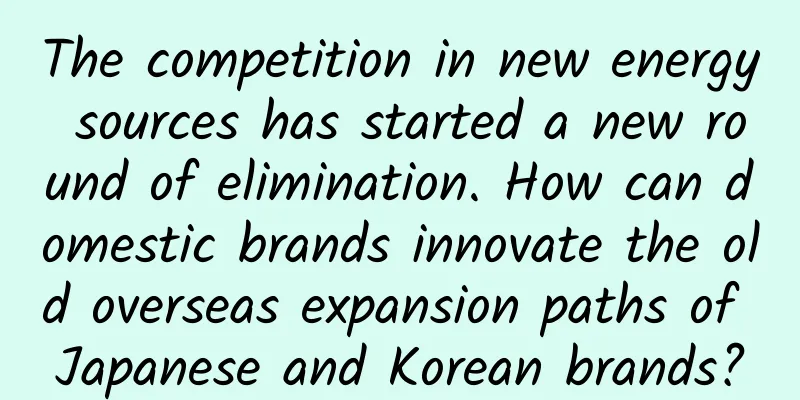The competition in new energy sources has started a new round of elimination. How can domestic brands innovate the old overseas expansion paths of Japanese and Korean brands?

|
It is almost well known that Japanese cars are selling well in the Chinese market. Although Korean cars are not as popular as before in the domestic market in recent years, they are still very popular in Europe and the United States, just like Japanese cars. According to official data, Beijing Hyundai sold a total of 502,000 new cars in 2020, and Dongfeng Yueda Kia sold a total of 249,300 new cars in 2020. In contrast, Korean cars performed well in the European and American markets. In 2020, Hyundai Kia Group achieved a total of 6.35 million car sales worldwide. Such sales results make us feel astonished. Many people are curious about how Japanese and Korean cars have grown from nothing to something, and then from weak to strong in the European and American markets. After all, Europe and the United States both have mature automobile industries and powerful automakers including General Motors and Volkswagen. In this regard, 91che will talk to you about the development history of Japanese and Korean cars in Europe and the United States, where the automobile industry is developed. Oil price increases at the right time The automobile industry of Japan and South Korea gradually developed on a large scale after World War II, but it was in the 1970s that they successfully entered the European and American markets, where many strong companies are present. Putting aside the United States, European automobile industry companies have been in a giant position since the middle of the last century. The reason why Korean and Japanese cars were able to successfully gain a foothold in the European and American markets in such a short period of time and quickly occupy the market of "indigenous" car companies on a large scale is that 91che believes there are two main reasons: first, Japanese cars are low-cost and fuel-efficient; second, European and American countries are experiencing an oil crisis. In the 1970s, two global oil crises were important factors affecting the development of the European and American automobile markets. The first oil crisis was caused by the Organization of Petroleum Exporting Countries (OPEC) announcing an oil embargo to combat Western countries’ support for their rival Israel, which caused oil prices in Western countries to rise. The second oil crisis was caused by the political turmoil in Iran, which led to a huge drop in Iran’s oil production. The price of a barrel of oil rose from less than $3 to $34 in ten years. The two oil crises had a huge impact on the US economy, with GDP falling by about 8%. Since then, the US government and the public have been calling for more fuel-efficient cars. In order to get rid of the oil control of the Middle East, the US government announced the fuel tax bill in 1978, requiring automakers to produce models with an average fuel consumption of 13L/100km today, and to reach 8.5L/100km in 1985. The introduction of this bill was a nightmare for American automakers at the time, after all, American automakers have always been known as "oil tigers". If American automakers want to produce products with low fuel consumption, they need to re-plan the research and development and manufacturing of existing product lines, and shift from the original single large-displacement, high-power products to increasing the production of small-displacement cars. However, the products in this market segment are completely unfamiliar to American automakers, so the quality of the products produced is poor and does not meet the expectations of consumers and the government. Japan's small, fuel-efficient cars just met the needs of the US market, and since then Japanese auto products have begun to emerge in the US market. Data shows that as soon as Toyota Corolla entered the US market, it quickly established a high reputation for quality, and the dissatisfaction rate of American consumers dropped from 4.6% in 1969 to 1.3% in 1973. Although the quality of subsequent automobile products produced by American automakers has met expectations and the technological gap in small cars has been basically eliminated, Japanese brands have established a good image of high quality and low price by building new factories in the United States. The average price of each Japanese car is 400-1000 US dollars lower than that of American cars, successfully occupying a large share of the US market. After witnessing the success of Japanese brands in the US market, Korean brands are not to be outdone. They almost copied the methods of Japanese brands and rapidly expanded their market share in the US market. After tasting the "sweetness" in the small car market, Japanese cars continue to expand their product lines and continue to attack the mid-size car market with fuel efficiency and outstanding quality. With the dual demand for fuel efficiency and large space continuing to ferment, Toyota Camry and Honda Accord have been popular in the market since they entered the US market. It should be noted that the same situation mentioned above also occurs in the European car market. Leapfrog upgrade, product strength is the key Exporting to overseas markets is not only the key to high growth in demand for automakers in various countries, especially for independent brands. With the domestic auto market becoming increasingly saturated, outward expansion may be a good opportunity. Therefore, many people have asked 91che whether we can learn from the successful cases of Japanese and Korean cars in the European and American markets, so that our new energy vehicles can be exported to overseas markets and marketed globally? The answer is yes. Although the external environment for the development of my country's auto industry is completely different from that of the past, with the help of the cases of Japanese and Korean brands seizing more market share in the European and American markets, we can get two inspirations: policy and technology. In terms of policy, the European and American markets have already increased their investment in the new energy vehicle market. According to information obtained by 91che, many countries or regions around the world have announced a timetable for banning fuel. From the perspective of time nodes, Norway and some central cities in some countries will ban fuel as early as 2025. With the Netherlands, Germany, India, the United Kingdom and other countries collectively banning fuel in 2030, the world will enter an intensive ban period. The countries or regions currently announced will ban the sale of fuel vehicles by 2040 at the latest. This is highly similar to the background of the United States restricting large-displacement vehicles mentioned above. The difference is that the United States previously promoted the promotion of small-displacement vehicles and got rid of the oil crisis, but now the world is developing new energy vehicles to achieve energy conservation and emission reduction. Taking the European market as an example, in order to promote the development of new energy vehicles, the EU and European governments have also introduced relevant policies, including the most stringent emission regulations and standards, increasing the intensity of subsidies, and so on. In terms of subsidies, the French government announced an 8 billion euro automotive industry aid plan in May last year, in which the government subsidy for C-end consumers of electric vehicles was increased from 6,000 euros to 7,000 euros, and the government subsidy for B-end consumers was 5,000 euros. The number of subsidies was limited to 200,000 vehicles, and electric vehicle subsidies and replacement subsidies could be used in combination, with a maximum subsidy of 12,000 euros. In addition to France, governments of Germany, the Netherlands and other countries have also issued corresponding subsidy policies. With policy support, it is very beneficial for independent brands to enter the European and American markets and subsequent promotion. In terms of technology, in the era of fuel vehicles, the core technological competitiveness of major automakers lies in engine technology, but in the era of electric vehicles, the "three-electric" system is a new core competitiveness. In terms of the three-electric system, our own brands have certain advantages. Take the motor as an example. Currently, there are only two electric car manufacturers in the world that have high-performance motors with a power of more than 200 kilowatts, one is Tesla and the other is NIO. NIO's independently developed high-performance asynchronous induction motor is the first to use copper rotor technology in China, with a thermal conductivity 40% higher than that of aluminum rotors. It also uses 1500-watt high-power laser welding technology to weld copper sheets to ensure that the rotor has excellent electrical conductivity and consistency. Whether it is a wheelbase of 420N·m or an ultra-secret speed of 15,000rpm, it ranks among the world's top. In addition to the leading advantages of my country's new energy vehicle companies in motors, my country also has leading advantages in many aspects such as intelligence and batteries. Especially in terms of batteries, whether it is CATL's ternary lithium battery or BYD's lithium iron phosphate battery, they occupy a large share of the global installed capacity, ensuring the stable development of my country's new energy vehicle production chain. The above two points are the necessary foundations for new energy vehicle companies to enter the global market, and are also the advantages that my country's new energy vehicle companies have successfully possessed. From the perspective of product strength, the future is definitely promising. As a winner of Toutiao's Qingyun Plan and Baijiahao's Bai+ Plan, the 2019 Baidu Digital Author of the Year, the Baijiahao's Most Popular Author in the Technology Field, the 2019 Sogou Technology and Culture Author, and the 2021 Baijiahao Quarterly Influential Creator, he has won many awards, including the 2013 Sohu Best Industry Media Person, the 2015 China New Media Entrepreneurship Competition Beijing Third Place, the 2015 Guangmang Experience Award, the 2015 China New Media Entrepreneurship Competition Finals Third Place, and the 2018 Baidu Dynamic Annual Powerful Celebrity. |
Recommend
The formula of ternary lithium battery materials is undergoing a revolution, less cobalt is becoming the trend, and cobalt-free is still a distant prospect
Recently, Japanese battery supplier Panasonic ann...
How to buy Meituan takeout red envelopes? Meituan takeaway red envelope purchase detailed process
How to buy Meituan takeout red envelopes? Meituan...
Kunshan Social Insurance Fund Management Center: National Internet Security Management Service Platform!
In order to protect network information security,...
Five rules to start your growth hacking journey
The Origins of Growth Hacking Originated from Sil...
Xi'an Sauna Leisure Club Experience Report, Absolutely Beyond Your Imagination
Xi'an Bath Club East Suburbs, South Suburbs, ...
Going to the hospital to clean your teeth is expensive and troublesome. Can you buy an instrument to clean your teeth at home?
Myth: **** “Can you buy equipment to ‘clean your ...
How to maximize the effectiveness of video, information flow and other platforms?
Today’s article is about: Marketing strategies fo...
Will long-term contact lens wear cause the cornea to become thinner? The possible damage is these...
...
1000+ complete set of BP and research report documents for the entire automotive industry
1000+ complete set of BP and research report docu...
Kingsoft Cloud signs contract with Xiongmai to build smart life
On December 30, Kingsoft Cloud and Xiongmai Techn...
Can data-driven operations really lead to rapid user growth?
As the saying goes, "Good wine needs no bush...
Do these 4 things regularly to make you look older than your peers! Huaxi doctors: You can effectively fight aging without spending money
Next Saturday is New Year’s Eve! During the Chine...
Multiple cases of hemorrhagic fever have been found in Xi'an. Can we still eat strawberries?
The day before yesterday, Xi'an News Network ...









